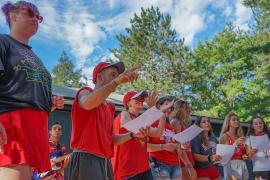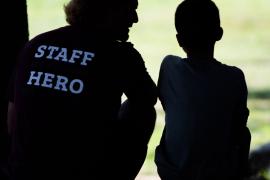Why are kids at camp so darn happy? It’s a relevant question as we embark upon another camp season. Of course, an important part of your job this summer will be to promote and enhance that happiness and to create a pathway for successful camper outcomes.
What do those outcomes look like?
ACA Outcomes and Research
For its part, the American Camp Association (ACA) highlights the value of experiential learning, stating, “At camp, when children make new friends, explore the world around them, and learn that ‘I can’ is much more powerful than ‘I can’t,’ magic happens. In an environment created just for them, children learn real life skills, develop self-esteem, and gain a sense of independence and community. Whether children are playing, exploring nature, conquering new heights, or becoming part of a camp family, they are creating memories that will last a lifetime” (ACA, 2018a).
ACA also speaks to gains in confidence, social skills, independence, and adventurousness (Wallace, 2017), and refers to the building of personal competencies. “These personal competencies are reflected in the four ‘C’s’ of the camp community: compassion, contribution, commitment, and character! For years, campers’ parents have reported that when their children return home from camp they are more caring, understand the importance of giving, are more equipped to stand up for what they know is right, and are willing to be more responsible. These are the qualities that will help build a successful nation and a civil society” (ACA, 2018b).
A Counterintuitive Conversation
A review of recent studies and statistics related to the state of youth mental health in general paints a wholly different portrait.
In a seminal 2016 TIME magazine cover story, “Teen Depression and Anxiety: Why the Kids Are Not Alright,” Susanna Schrobsdorff referred to the “compulsive manifestation of the depression and anxiety” plaguing young people across the United States (Schrobsdorff, 2016).
She says, “Adolescents today have a reputation for being more fragile, less resilient, and more overwhelmed than their parents were when they were growing up. Sometimes they’re called spoiled or coddled or helicoptered. But a closer look paints a far more heartbreaking portrait of why young people are suffering. Anxiety and depression in high school kids have been on the rise since 2012 after several years of stability. It’s a phenomenon that cuts across all demographics — suburban, urban, and rural; those who are college bound and those who aren’t. Family financial stress can exacerbate these issues, and studies show that girls are more at risk than boys.”
To that point, school counselors at a private primary school in Chicago recently told me about the high spikes in anxiety they are seeing in seventh-grade girls worrying about earning the grades to be admitted to the best high schools.
As for Schrobsdorff, compelling examples of what she referred to can be found in the retelling of stories of Faith-Ann and “Josh.”
According to the TIME article, Faith-Ann, then an eighth grader, “cut herself . . . as her parents slept, she sat on the edge of the tub at her home outside Bangor, Maine, with a metal clip from a pen in her hand . . . . ‘It makes the world very quiet for a few seconds,’ says Faith-Ann. ‘For a while I didn’t want to stop, because it was my only coping mechanism. I hadn’t learned any other way.’”
And “Josh,” then a tenth grader who did not want his real name published, “says he remembers how his parents began checking on him after the Sandy Hook shooting that killed 20 children and six adults. Despite their vigilance, he says, they’re largely unaware of the pain he’s been in. ‘They’re both heterosexual cis people, so they wouldn’t know that I’m bisexual. They wouldn’t know that I cut, that I use red wine, that I’ve attempted suicide,’ he says. ‘They think I’m a normal kid, but I’m not’” (Schrobsdorff, 2016).
The Child Mind Institute, in its 2016 Children’s Mental Health Report, stated, “Mental health disorders are the most common health issues faced by our nation’s school-aged children. One in five children suffers from a mental health or learning disorder, and 80 percent of chronic mental disorders begin in childhood” (Child Mind Institute, 2016).
In an article for Psychiatry Advisor, Avital E. Falk and John T. Walkup, MD, report, “Anxiety disorders constitute the most prevalent class of mental health problems in children and adolescents, with prevalence rates estimated from 15–20 percent” (Falk & Walkup, 2015).
Sadly, anxiety has a well-known close cousin: depression.
The National Institute of Mental Health (NIMH) explains, “About 11 percent of adolescents have a depressive disorder by age 18 . . . . Girls are more likely than boys to experience depression. The risk for depression increases as a child gets older. According to the World Health Organization, major depressive disorder is the leading cause of disability among Americans age 15 to 44” (NIMH, 2015).
As you may have guessed, it can be a short hop, skip, and jump from depression to suicide.
Alarmingly, suicide among teens and young adults has nearly tripled since the 1940s, according to the Centers for Disease Control and Prevention (CDC). It states, “Suicide is a serious public health problem that affects many young people. Suicide is the third leading cause of death for youth between the ages of 10 and 24, and results in approximately 4,600 lives lost each year” (CDC, 2017).
The CDC adds, “Deaths from suicide are only part of the problem, because more young people survive suicide attempts than actually die.”
Signs and Symptoms
How will you, as a camp counselor, know if a camper is depressed and thinking of dying by suicide? NIMH offers the following signs and symptoms (2015).
- Often feels anxious or worried
- Is in constant motion, can’t sit quietly for any length of time
- Has trouble sleeping, including frequent nightmares
- Loses interest in things he or she used to enjoy
- Has low or no energy
- Has spells of intense, inexhaustible activity
- Harms herself or himself, such as cutting or burning her or his skin
- Engages in risky, destructive behavior
Of course, he or she may actually tell you. So be sure you know your camp’s protocols on how to take immediate action to keep a camper safe.
Campers Speak to Successful Camp Outcomes |
|
Here is some commentary from campers completing their final summer at Cape Cod Sea Camps in 2017. Joe Melfi said, “Camp prepared me to be successful and for leading others to find success. Most important, it has molded me into the young man I am today. Almost all of my social skills have come from meeting new people at camp. My drive to succeed and to never give up came from the inherent challenges of being a sailor. That alone could qualify me for the colleges I’m applying to. I mean, who doesn’t want a leader who can empathize with people?” Gianna Ferrara wrote, “Camp provided an early chance for me to learn independence by living away from home for an extended amount of time. Camp also gave me the opportunity to build lifelong relationships. Encountering a variety of people and ideas, I learned how to live and cooperate with others and become more open minded. Camp has also been probably the biggest influence on my character, preparing me to do well in the future.” Luke Howes told me, “Camp helped to prepare me for the future by putting me with a group of people who were much different from my friends at home. Becoming friends with kids from all areas has helped me to learn how to interact with a variety of people. My last summer provided insight into what I would like to do later in life and helped me to learn things about myself that I hadn’t been aware of before.” Brooke Hackel stated, “There are a few crucial lessons camp has taught me. First is how to be a leader. Second would be that hard work pays off. To be able to work hard so I can excel in my academics and have fun in my other time will help me be successful and happy. Third is developing people skills. At camp one meets so many different people and learns how to get along with, and live amongst, them.” And Andrew Parry weighed in, saying, “My experiences at camp have not only helped me improve my ability to settle into a new environment quickly, they’ve helped me to become a better leader, a better friend, and a more open-minded, patient, and empathetic person.” What about the counselors? Liz Day, who has been associated with camp for many years, spoke to her experiences and offered, “As both a camper and counselor, camp was always the highlight of my year. I found that the positive community allowed me to break out of my reserved shell. Over time I was no longer referred to as ‘sweet and quiet Liz’ but rather as a capable leader. This is what I think camp is all about: having the opportunity to grow as a person and find out who you truly are. As a counselor last summer I was shocked to find out that many of my campers who seemed carefree and completely at ease suffered from mental health problems such as depression and anxiety. It proved to me that camp really is magical and like no other place, providing a safe and nurturing environment that allows anyone to overcome struggles they are facing.” |
Camp and Smartphones
One reason why summer camp may seem an outlier to the general trends in youth mental health could have to do with the imposition of limits on, or downright exclusion of, access to smartphones.
In her November 2017 article, “With Teen Mental Health Deteriorating Over Five Years, There’s a Likely Culprit,” Jean Twenge, professor of psychology at San Diego State University, points to evidence of a link between the proliferation of smartphones and increasing rates of mental health issues among young people. She says, “Around 2012, something started going wrong in the lives of teens. In just the five years between 2010 and 2015, the number of US teens who felt useless and joyless — classic symptoms of depression — surged 33 percent in large national surveys. Teen suicide attempts increased 23 percent. Even more troubling, the number of 13- to 18-year-olds who committed suicide jumped 31 percent” (Twenge, 2017).
Might the Kids Be All Right Sans Smartphones?
Surprisingly, an August 2016 segment of National Public Radio’s All Things Considered revealed that young people at camp may come to appreciate the lack of time on their phones (Smith, 2016).
“‘I haven’t read a book in like five years, and I just recently started reading one,’ says 16-year-old Jonah Bachman. ‘I forgot how much I loved reading!’ Since quitting his phone habit, he says he’s also more engaged with friends and the outdoors. ‘Often times I’ll sort of just find myself walking around, like enjoying, like you know going down to the ocean, just sort of being there,’ he says.”
Similarly, 17-year-old Aggie states that she is “actually able to be more herself. And she says being phone-free has also led her to make friends with kids who are not exactly in her comfort zone — kids she would never even talk to at home. ‘I think a cell phone’s a virtual wall that you put up for yourself,’ she says. ‘You’re on your phone, and it’s like you don’t need to communicate with this person. You just don’t have to’” (Smith, 2016).
A Journey Back to Nature
Of course, there are many factors that play into one’s happiness at camp, not the least of which may be the positive effects of being outside enjoying the types of natural habitats camps typically provide.
In a Camping Magazine interview, “The Restorative Powers of Nature,” Florence Williams, a contributing editor at Outside Magazine, highlights this phenomenon. Williams says, “I concluded that . . . our brains evolved in nature and there is some very fundamental comfort that kicks in . . . . On some level our bodies and brains just relax when we’re outside. As long as we know that being outside facilitates other health effects — fresh air, exercise, being connected with our friends, being disconnected from technology — there are all these amazing things that come together when we’re outside.”
Asked for her advice for you, Williams offers, “Some of the evidence we have really suggests that kids can benefit from, not only time outside, but unstructured time in nature — when they can just experience time running around on their own, where they can gaze up at the stars for a long time and be wowed by the beauty of the universe, or discover a really cool log, or the sound that their paddle makes in a canoe” (Camping Magazine, 2018).
Some Really Good News about Developmental Assets
While you may not have direct control over your camp’s technology policy or the remedies for anxiety, depression, or suicidal ideation in your campers, there are things you can intentionally do that will increase the likelihood the kids in your care will experience happiness and success during the summer of 2018.
In that regard, the Search Institute offers up some advice on helping young people attain what they refer to as “developmental assets.”
Spanning eight categories (Support; Empowerment; Boundaries and Expectations; Constructive Use of Time; Commitment to Learning; Positive Values; Social Competencies; and Positive Identity), such assets are easy for you to apply and encourage.
More granularly, the recommendations speak to the inherent value of the following constructs and actions (Search Institute, 2007):
- Other adult relationships
- Caring schools and communities
- Opportunities to serve others
- Family, school, and neighborhood boundaries
- Positive role models
- Creative, fun activities
- A sense of achievement
- Modeling of positive values
- Learning to plan and make positive choices
- A sense of control, purpose, and hope for the future
Happy Campers and Counselors
At the end of the proverbial day (or camp season), you may look back on the extraordinary opportunity you had in influencing youth to be happy, healthy, and productive citizens of the world.
References
American Camp Association. (2018a). The camp resource for families. ACA. Retrieved from ACAcamps.org/campers-families
American Camp Association. (2018b). Benefits of camp. ACA. Retrieved from ACAcamps.org/campers-families/because-camp/benefits-camp
Camping Magazine. (2018, January). The restorative powers of nature: An interview with Florence Williams. Camping Magazine. Retrieved from ACAcamps.org/resource-library/camping-magazine/restorative-powers-nature
Centers for Disease Control and Prevention. (2017, September 15). Suicide among youth. CDC. Retrieved from cdc.gov/healthcommunication/toolstemplates/entertainmented/tips/SuicideYouth.html
Child Mind Institute. (2018). 2016 Children’s mental health report. Retrieved from https://childmind.org/report/2016-childrens-mental-health-report/
Falk, A., & Walkup, J. (2015, August 19). Anxiety disorders in children adolescents, and emerging adulthood. PsychiatryAdvisor.com. Retrieved from psychiatryadvisor.com/about-us/section/4046/
National Institute of Mental Health. (2016). Depression basics. NIMH. Retrieved from nimh.nih.gov/health/publications/depression/index.shtml
National Institute of Mental Health. (2015). Depression in children and adolescents fact sheet. Children’s Mental Health Awareness. NIMH. Retrieved from https://polaristeen.com/wp-content/uploads/2015/04/depression-in-children-and-adolescents.pdf.pdf
Schrobsdorff, S. (2016, October 27). Teen depression and anxiety: Why the kids are not alright. TIME. Retrieved from http://time.com/4547322/american-teens-anxious-depressed-overwhelmed/
Search Institute. (2007). 40 developmental assets for adolescents. Retrieved from search-institute.org/content/40-developmental-assets-adolescents-ages-12-18
Smith, T. (2016, August 11). Summer camps struggle to enforce bans on screen time. All Things Considered. National Public Radio. Retrieved from npr.org/2016/08/11/489661961/summer-camps-struggle-to-enforce-bans-on-screen-time
Twenge, J. (2017, November 14). With teen mental health deteriorating over five years, there’s a likely culprit. The Conversation. Retrieved from https://theconversation.com/with-teen-mental-health-deteriorating-over-five-years-theres-a-likely-culprit-86996
Wallace, S. (2017, September 8). A happy camper. HuffPost. Retrieved from huffingtonpost.com/stephen-gray-wallace/a-happy-camper_1_b_5570839.html
Stephen Gray Wallace, MS Ed, is president and director of the Center for Adolescent Research and Education (CARE), a national collaborative of institutions and organizations committed to increasing favorable youth outcomes and reducing negative risk behaviors. He has broad experience as a school psychologist and adolescent/family counselor. He serves as director of counseling and counselor training at Cape Cod Sea Camps, a member of the professional development faculty at the American Academy of Family Physicians and the American Camp Association, and a parenting expert at kidsinthehouse.com, NBCUniversal’s parenttoolkit.com, and WebMD. He is also an expert partner at RANE (Risk Assistance Network & Exchange) and was national chairman and chief executive officer at SADD for more than 15 years. Additional information about Stephen’s work can be found at StephenGrayWallace.com.
© Summit Communications Management Corporation 2018. All Rights Reserved
Discussion Questions |
|




